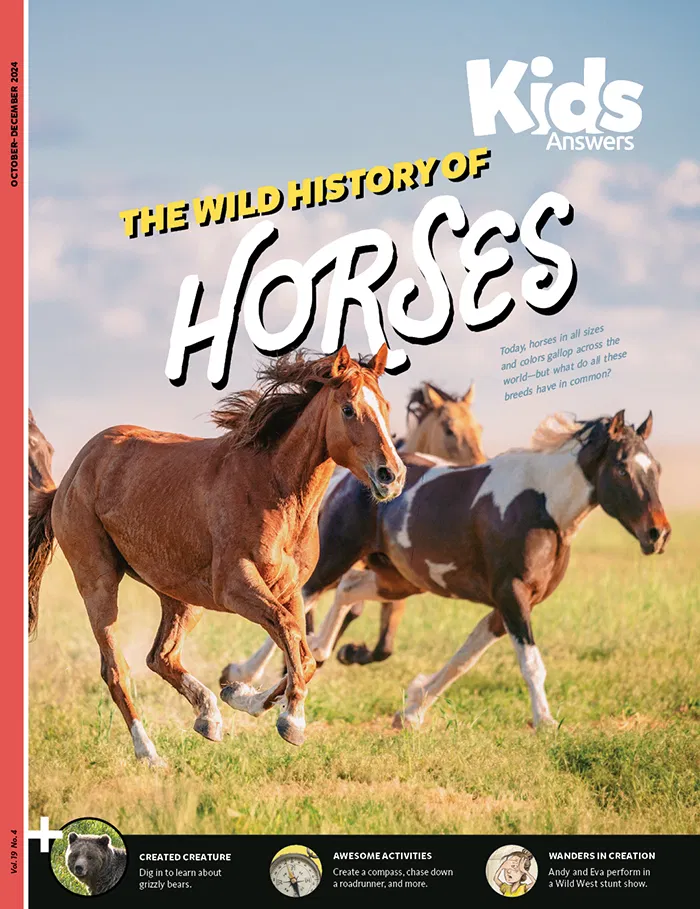Your Big Questions

I’m Lily! You might know me from my Answers TV show Lily’s Lab, where we ask questions and find answers. Let’s look at some big questions from kids like you!
Alivia asks
Why do we have different hair colors?
Great question, Alivia!
Your hair color comes from a pigment called melanin (MEL-uh-nin). There are two kinds of melanin: eumelanin (yoo-MEL-uh-nin) and pheomelanin (fee-eh-MEL-uh-nin). All human hair has both pigments, but if you have dark hair (brown or black), you have more eumelanin in your hair. If you have light hair (blonde or red), you have more pheomelanin in your hair.
The levels of melanin can change over time, causing hair color to change. For example, the production of melanin can slow as a person ages, turning hair gray or white.
Did you know that melanin also determines the color of your skin? We all have the same basic skin color: brown. More melanin makes someone’s skin darker brown, while less melanin makes skin lighter brown. When God created the first two humans, Adam and Eve, on day six of creation week, they probably had a middle-brown shade of skin. Some of their children probably had light brown skin while others had dark brown skin.
Some nationalities are more likely to have dark hair and skin. This is due to genetics, the traits that get passed down from their parents. When people spread out across the world at Babel (Genesis 11), different people groups passed on the genetics for certain skin and hair shades.
We are all descendants of Adam and Eve. From these first two people came all the different hair colors and skin shades we see today. And no matter your skin shade or hair color, you were made in God’s image (Genesis 1:27)—and God loves you very much (1 John 3:1).
Elijah asks
How do you make clay?
Good question, Elijah!
Clay comes mostly from igneous (IG-nee-uhs) rocks that were formed from cooling and hardening magma (melted rock). When these rocks interact with water, air, or steam, they experience a process called weathering, which breaks down the minerals in those rocks. Some of these minerals break down into soft and sticky clay minerals.
We use clays for things like plates and cups, bricks and floor tiles, jewelry, and more. Clays have always been a popular building material. At dig sites, archaeologists often uncover clay artifacts, which help us understand how people lived thousands of years ago.
Charlie asks
If the stars have only been shining for about 6,000 years, how does light from stars that are millions of light-years away get to earth where we can see it?
Hi, Charlie!
The term light-year is not a measure of time but a measure of distance, telling us how far away something is. Distant stars and galaxies might be millions of light-years away, but that doesn’t mean that it took millions of years for the light to get here—it just means it is really far away!
When God created the universe, everything was already working perfectly. So the stars could be seen on earth as soon as God spoke them into existence on day four of creation week. It’s not a problem for our all-powerful God to get light from distant galaxies to earth in a short period of time!
Mary and John ask
Why is Genesis 1–11 foundational for everything?
Thanks for your question!
Everything Christians believe is founded on what the first 11 chapters of Genesis tell us. In these chapters, we can find answers to important questions: Where did everything come from (Genesis 1)? Why are we sinners (Genesis 3)? Why did Jesus need to die (Genesis 3)? Why do we wear clothes (Genesis 3:21)? What is marriage (Genesis 2:24)? Where did all the different languages come from (Genesis 11)?
Because Genesis tells us that God created everything, the book gives us a foundation for understanding science, such as biology and astronomy. The account of Noah’s flood also shows us that most rock layers and fossils are less than 4,500 years old, not millions of years like evolutionists believe.
Ask Your Big Questions
Do you have a question about God’s Word or his world? Is there a topic you want to learn more about? Ask your parents to help you submit your question today. We’d love to hear from you!
Kids Answers
PO Box 510
Hebron, KY 41048
Kids Answers Magazine
The Wild History of Horses
Today, horses in all sizes and colors gallop across the world—but what do all these breeds have in common?
Browse Kids Issue- © 2024 Answers in Genesis
- Privacy Policy
- Contact
- About

